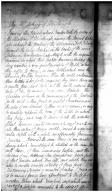[ On the Sugar of Milk ] Dr. William James Almon
Date: 1792/05/01
Source:
Manuscript Notebook of Dr. William James Almon
Institution: Nova Scotia Archives
| Source Origin: Almon Family Fonds
| Reference: MG 1 / Microfilm Reel 10,045
A detailed description of a method for extracting powdery sugar from milk used in the cold dry climate of Irkutsk, pp. 235-36. The account, by Mr. Jahrig of Petersburgh, was translated from French and published in May 1792 in The Literary Magazine and British Review Vol. 8, pp. 328-30.
On the Sugar of Milk
By Mr. Jahrig of Petersburgh
During the travels which I undertook by order of
the Academy of Petersburgh, among the Mogul tribes
who inhabit the frontiers of the government of Irkutz
beyond the lake Baikal, on the banks of the river
Salenga, I was particularly stuck with the ingenious
manner in which these people preserve during their
long winters, a very great quantity of Milk, which
they suffer to freeze, in iron kettles, which serve the[m]
likewise for other purposes. When the milk contained in
These kettles is perfectly congealed, they place them over
a gentle fire, and take out the milk, reduced to a
cake of ice, by means of a wooden spatula. This
operation is begun on the commencement of the first cold
for the milk is then found in greatest abundance, and
the cakes of ice obtained by these means assume, as may
be readily supposed the form of the kettle in which
they freeze, and may be preserved all the winter.
What, however excited my curiosity most was to see
all these cakes of frozen milk, covered to a conside-
rable depth with a white and apparently farinaceous
powder--I observed the same thing in my small
dairy which I was obliged to establish on the same plan[e]
with those of, of these wandering people, and the
children of my shepherds often brought me plate-fuls
of that powder which they ate, and which they used
also to sweeten various articles of their food. After
this discovery I caused a number of cakes of frozen milk
to be conveyed from a lower apartment to the top of a
wooden House which I occupied, and which was a
part of a temple consecrated to the idols of these
pagan People. These cakes in that place were exposed to
the immediate contacts of the dry cold air, which prevails
in that country almost the whole year. These cakes were
placed perpendicularly, and by these means were more expo
-sed to the effects of the air. I visited them very often and I
perceived that this exposure contributed daily to increase
the farinaceous substance, with which their surface was
covered. Every week I took it away by scraping the
cakes, to the depth of two inches, and afterwards spread
it out upon a broad dish, in order that the cold might
destroy any remains of moisture, which would have
prevented it from keeping for a length of time. This
flour when thus exposed to a great degree of cold, and
consequently freed from all its moisture, had a remark
-able sweet and sugary taste. If dissolved in warm
water, and when strongly stirred by means of a chocolate
stick, one may procure from it, at all times and in all
places excellent and well tasted milk. This discovery
I consider as of great utility, since it may enable
navigators to supply themselves with milk during
long sea-voyages. Nothing will be requisite but to
make the necessary preparations with care.
As I here speak of an experiment which I repeated seve
-ral times, I can safely assure those who may be
disposed to try it, that it will always succeed, but
at the same time, I am inclined to think that all
countries will not be equally favorable to the
formation of this singular substance. The country
in which I then resided, is one of the most elevated in
the northern part of Asia, an alpine country, where
the rivers are covered with ice, almost six months in
the year, though it lies under the fiftieth degree
of latitude.
Another peculiarity of this country, is the dry cold air,
which prevails in it for a great part of the year. Dry
winds as well as rain and snow, seldom come from the
west: they come almost always from the North, and are
generally preceded by a very mild South wind which
blows for some time. The dry rarified air which continues
here all winter increases the evaporation of all
moisture contained in these ice cakes, and leaves
nothing but the milk, the essential and so constituent
part, under the form of a white powder.
To obtain, in a little time, a large quantity of this {...}
it will be necessary to employ raw, in preference to, boiled
milk. By making use of the latter, or that from
which the cream has been taken, little or none
will be obtained. Care also must be taken not
to expose new milk, while it retains its natural
heat, to the cold; for the sudden contact of the cold
carries all its fat and caseous parts, towards the
middle of the mass, so that the parts purely
aqueous alone occupy the external surface. The
interior part, which then appears rough, is often chang-
-ed into a buttery substance, and produces no suga-
-ry powder. That all the fat and sugary parts
might be more equally distributed throughout
the whole mass of milk, I suffered that newly
taken from the cows to cool, and then pouring it
into broad shallow kettles.
Download: Transcription | Images

